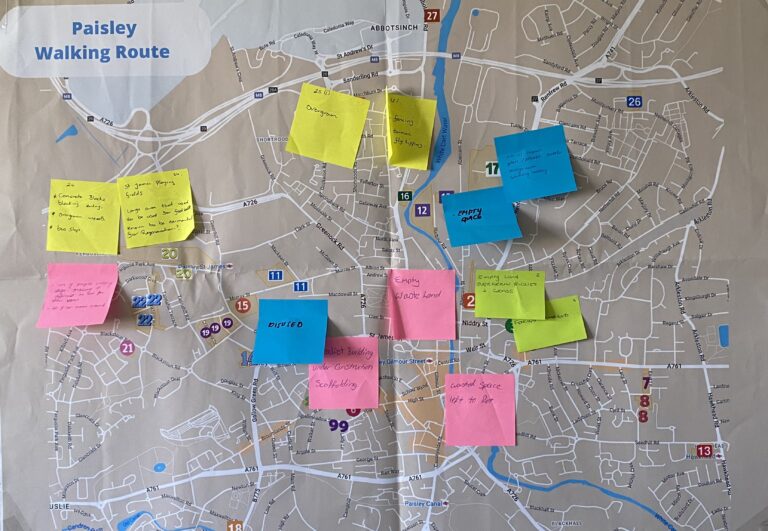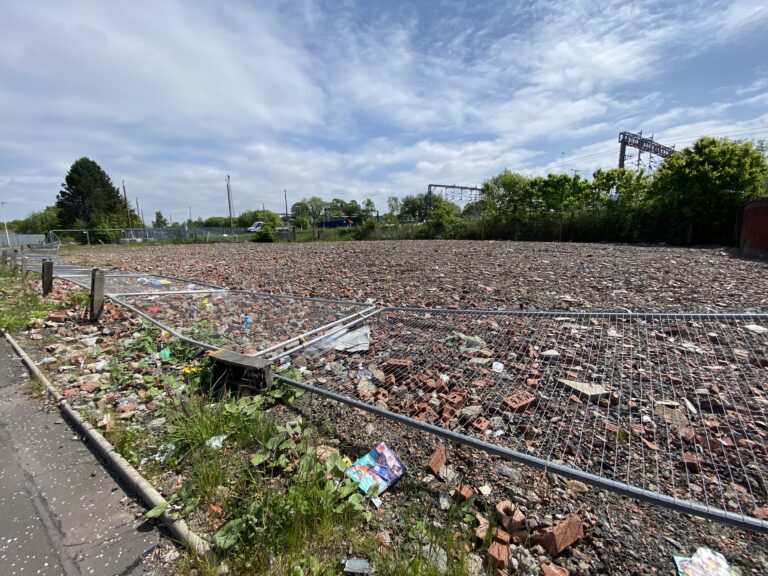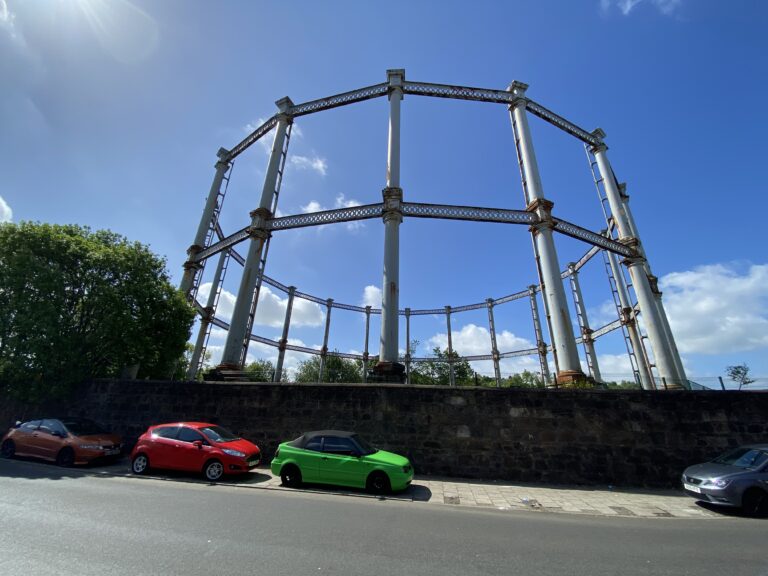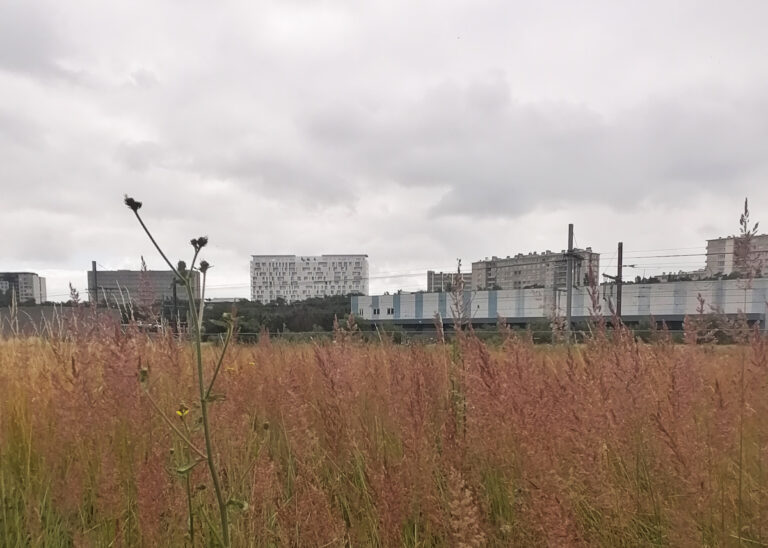Photo credits: Unsplash David Clode 2021 (left); Unsplash Jonathan Kemper 2021 (right)
You might have noticed it walking through towns or cities; spaces that are left to deteriorate, with smashed windows and litter everywhere, or sites that are completely overgrown. Perhaps you have noticed how these spaces attract antisocial behavior, including littering or vandalism. Still, these spaces, whether small or big, are sites of opportunity that are just waiting for the right eye and effort to transform them into a community asset. Imagine transforming these overlooked sites into thriving public spaces that provide social and ecological benefits. Marlene Zijlstra Marlene Zijlstra is currently pursuing a PhD in decaying spaces and regeneration in Paisley, Scotland, and shares her insights on this topic in this post.
Learnings from Paisley, Scotland
CONTEXT:
Especially in post-industrial cities in Scotland, decaying spaces have become a palpable reality. In 2021, Scotland housed almost 11.000 ha of vacant and derelict urban land. This is comparable to 27 football fields. This problem is particularly acute for the country’s inhabitants, as almost 1/3 of all Scots live within 500 meters of a derelict site. Furthermore, persisting decaying sites are often found in neighborhoods already experiencing socio-spatial inequalities. This often means that through understanding a decaying space, you often work with communities that are already facing a significant gap in income or access to resources such as healthcare.
Located less than 10 miles from Glasgow, Paisley is the largest town in Scotland and a very exceptional case in regards to decay. Seen as the administrative center of Renfrewshire, it has a population of about 77.000 inhabitants. In the 19th century, the town became famous for its weaving industry, with the ‘Paisley pattern’ and ‘Paisley shawls’ becoming internationally known cultural artifacts.
However, in the second half of the 20th century, the town underwent a steep urban decline, mainly because of the increase in global competition and the shift of production overseas – creating persisting local economic and social inequalities in working-class neighborhoods that were dependent on the industry for work.
This development also translated itself to an increase in decaying sites across Paisley. These sites range from big abandoned heritage buildings in the town center to small decaying gap sites in the surrounding neighborhoods. Paisley actually has a very impressive architectural base, and holds the largest concentration of listed buildings per capita in Scotland outside of Edinburgh.
In practice most of these spaces are owned by private landowners, and the council is subject to the owner to determine what can happen to a space. As such, many sites are laying empty until the neighboring property prices go up. Furthermore, due to criteria set by the council, data about the history and owners of sites are only being gathered on big sites across the town of 0.1 ha and up. As a result, smaller gap sites stay hidden from view.
SHEDDING LIGHT ON DECAYING SPACES
It became clear that it was important to establish a local-specific picture of decay in Paisley. This included gathering information on decaying spaces by engaging with various community members to discuss the terminology of decay, locations of decay, and imaginations for re-use.
As you’re probably well aware, local residents are often the best source of knowledge about their surroundings. In Paisley, engaging with these citizens was crucial – they are experts on the local landscape, possess valuable insights into the area’s culture and history, and can attract community value to neglected spaces.
To uncover local knowledge, Marlene organized a workshop to let community members explore decaying spaces, and held interviews with key changemakers in the town. These included architects, council members, community artists, community representatives, and activists. From these insights, she created an accompanying website and Instagram that features a database of visible and hidden sites of decay. The website and Instagram function as a community repository, and she plans to give both sources to the community as a legacy project once she finishes her PhD.
FINDINGS FROM THE LOCALS
Paisley is a very proud town with a very rich architectural legacy but similarly has a very strong history of community activism. “People here aren’t afraid to tell what still needs improvement. Through conversations with locals, it became clear that there was a call for spatial ‘justice’ – ensuring that every community member has access to, and can enjoy, green spaces outside of their homes.”
- Disused, Empty and Derelict were the three most common words used to talk about and discuss decaying spaces in Paisley by all people involved in this research.
- While the town has some green areas, most of those are used by dog walkers who remain irresponsible in cleaning up, thereby leaving the area unfit for playing outside or having family get-togethers.
- Gardening, Food Stalls and (free) social meeting places were highlighted as the top three most preferred re-use projects. Overall, food culture (from growing to selling) was highlighted as an important theme.
- Most participants welcomed the addition of more green spaces across town that are specifically catered to young adults and families. Most areas that exist currently are unsafe or unfit for usage.




If you want to repeat the study in your town
The workshop I set up was part of a project I called Hidden Spaces Paisley. The project was meant to let communities think about four principal questions regarding decaying spaces:
- What we call them
- What they are
- What they represent
- What they can become
The project consisted of a walking route past known decaying spaces in Paisley. These were spaces that were listed by the local council as ‘derelict’ or ‘vacant’. In addition, participants were asked to take some time to photograph other sites in their neighborhoods that they would consider a decaying space. During both activities, participants answered questions about the sites that they visited. After both activities were finished, I held a feedback meeting to chat with the participants about what stood out to them, and hear their input in regards to re-use opportunities.
The photographs that were made by participants were gathered and became the basis for the Hidden Spaces Paisley website. On the website, I describe my research, but also curated a Hidden Spaces database with photos, videos and maps of decaying spaces in Paisley. The website and accompanying Instagram are meant to increase accessibility about spaces in people’s neighborhood and encourage community members to send pictures and videos of other spaces in Paisley that they run into. This forms the basis of letting both resources eventually become community-run.
Barriers for participation
There of course were barriers that presented themselves when setting up and carrying out the workshop. These are four key takeaways from my own research:
- Make sure you have trust established in the community before running any type of project. For my research, I specifically worked with an award winning community organization in Paisley that is targeted to individuals that experience hardship in various aspects of life. This organization works hard to give a sense of emotional health, confidence and hope back to individuals in the wider Renfrewshire area. These types of organizations are oftentimes the gatekeepers to the community, meaning that if the organization trusts you, then the wider community will as well. In addition, I would encourage anyone thinking of undertaking such a study to take some time to show your face around town, get acquainted with the locals and engage in other events that are being set up (i.e. street cleanup days, cultural celebrations or community council nights).
- How I identified the community organization that I worked with:
- I explored the contacts that my university had in the town
- Had fieldwork trips to familiarize myself with the town, visit derelict areas and chat to different community organizations about my research
- I talked to various cultural organizations about which community organizations they regularly work with
- I looked at which organizations are currently receiving government/private funding and have a full program of events running
- I read up on the history of the town and the rooted organizations that have been around for a long time
- As a result, I had 6 potential organizations to work with. After pitching my research (keeping in mind the timeline of my PhD), I made the decision to work with one specific organization. This decision was mainly based on their wider reach in the community, their previous collaboration with university partners, their inclusiveness in terms of target groups, and the opportunity to host multiple workshops at that same location.
- How I identified the community organization that I worked with:
- Never stop thinking about accessibility and the barriers to entry. If you are doing a walking exercise, there are always people who will be less inclined to participate. Think about ways to circumvent this, for instance by deploying bike/car services for particular participants, and not just focusing on what decay you can see, but also what decay you can experience through the other senses (i.e. touch and sound).
- Be flexible! Especially in working with community members. If the project is one designed for them, then let them decide how it should be designed and how they wish to engage from the start.
Work with an established feedback loop: be transparent and let participants know what you will do with their input. Also be sure to send them updates and keep them informed on progress. One big factor of mistrust with communities is that they give their input and never hear anything else back again. Make sure to include them in next steps and give them a way to stay involved.
References:
- Yates, G. (2021) Changing Urban Contexts: Delivering a Healthy and Inclusive Green Recovery for Glasgow. Glasgow Centre for Population Health. https://www.gcph.co.uk/assets/0000/8116/Changing_urban_contexts_report.pdf.
- Carpenter, j. (2022) Picture This: Exploring Photovoice as a Method to Understand Lived Experiences in Marginal Neighborhoods. Urban Planning, 7(3), 351-362. https://www.cogitatiopress.com/urbanplanning/article/view/5451/5451.
- Edensor, T. (2005) The Ghosts of Industrial Ruins: Ordering and Disordering Memory in Excessive Space. Environment and Planning D: Society and Space, 23(6), 829–849. https://doi.org/10.1068/d58j.
- Pareja-Eastaway, M. (2020) The Generation of Value in Urban Spaces. Equilibri Special Issue 2020, 102-116. 10.1406/98103.
To learn more about the research, go to www.hiddenspacespaisley.com or follow @hiddenspacespaisley on Instagram!
